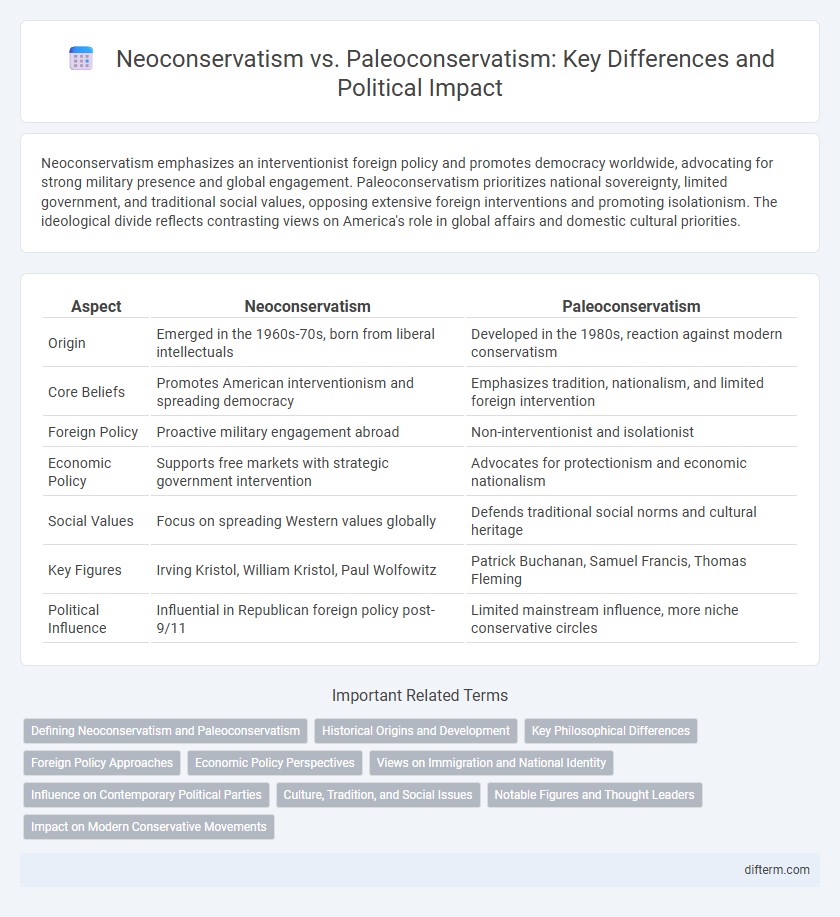Neoconservatism emphasizes an interventionist foreign policy and promotes democracy worldwide, advocating for strong military presence and global engagement. Paleoconservatism prioritizes national sovereignty, limited government, and traditional social values, opposing extensive foreign interventions and promoting isolationism. The ideological divide reflects contrasting views on America's role in global affairs and domestic cultural priorities.
Table of Comparison
| Aspect | Neoconservatism | Paleoconservatism |
|---|---|---|
| Origin | Emerged in the 1960s-70s, born from liberal intellectuals | Developed in the 1980s, reaction against modern conservatism |
| Core Beliefs | Promotes American interventionism and spreading democracy | Emphasizes tradition, nationalism, and limited foreign intervention |
| Foreign Policy | Proactive military engagement abroad | Non-interventionist and isolationist |
| Economic Policy | Supports free markets with strategic government intervention | Advocates for protectionism and economic nationalism |
| Social Values | Focus on spreading Western values globally | Defends traditional social norms and cultural heritage |
| Key Figures | Irving Kristol, William Kristol, Paul Wolfowitz | Patrick Buchanan, Samuel Francis, Thomas Fleming |
| Political Influence | Influential in Republican foreign policy post-9/11 | Limited mainstream influence, more niche conservative circles |
Defining Neoconservatism and Paleoconservatism
Neoconservatism emphasizes an interventionist foreign policy, promotion of democracy abroad, and a strong national defense, rooted in a belief in American exceptionalism and global leadership. Paleoconservatism advocates for limited government, non-interventionism, and cultural traditionalism, stressing national sovereignty and skepticism of globalism. The ideological divide centers on foreign policy approaches and cultural values, reflecting differing visions of America's role in the world.
Historical Origins and Development
Neoconservatism emerged in the 1960s among former liberals disillusioned with the counterculture and the welfare state, advocating for a strong national defense, free-market capitalism, and an interventionist foreign policy. Paleoconservatism traces its roots to traditionalist conservatives of the early 20th century, emphasizing limited government, cultural preservation, and non-interventionism. Both movements evolved as reactions to modern political and social changes, with neoconservatism focusing on global leadership and paleoconservatism stressing regionalism and heritage.
Key Philosophical Differences
Neoconservatism advocates for an interventionist foreign policy promoting democracy and American values globally, emphasizing strong alliances and military engagement. Paleoconservatism prioritizes national sovereignty, cultural traditionalism, and non-interventionism, favoring restrained government and preservation of established social orders. These philosophical differences shape divergent approaches to foreign policy, immigration, and government scope within the conservative movement.
Foreign Policy Approaches
Neoconservatism advocates for an interventionist foreign policy, emphasizing the promotion of democracy and American values through military engagement and international alliances. Paleoconservatism favors a non-interventionist approach, prioritizing national sovereignty and cautioning against entangling alliances and prolonged foreign conflicts. This ideological divide influences debates on U.S. military involvement and diplomatic strategies worldwide.
Economic Policy Perspectives
Neoconservatism advocates for free-market capitalism with moderate government intervention to promote economic growth and global competitiveness, emphasizing globalization and international trade agreements. Paleoconservatism favors protectionist economic policies, prioritizing national sovereignty, traditional industries, and skepticism toward multinational corporations and global trade deals. Both perspectives diverge sharply on immigration's economic impact, with neoconservatives supporting labor mobility and paleoconservatives endorsing restrictive immigration policies to protect domestic jobs.
Views on Immigration and National Identity
Neoconservatism advocates for a more open immigration policy emphasizing assimilation and the promotion of democratic values, while paleoconservatism supports strict immigration controls to preserve traditional national identity and cultural homogeneity. Neoconservatives often view immigration as a means to strengthen the economy and global influence, whereas paleoconservatives prioritize sovereignty and protection of established social norms. The ideological divide centers on balancing national security with cultural integration in shaping immigration policies.
Influence on Contemporary Political Parties
Neoconservatism significantly influences contemporary political parties through its emphasis on aggressive foreign policy, promotion of democracy abroad, and strong national defense, impacting groups like the Republican Party in the United States. Paleoconservatism shapes political discourse by advocating for limited government, national sovereignty, and traditional social values, resonating with factions skeptical of globalization and interventionism. The ideological divide between these conservatisms affects party platforms, voter bases, and policy priorities, contributing to ongoing intra-party debates and political realignments.
Culture, Tradition, and Social Issues
Neoconservatism advocates for a proactive international stance and embraces cultural pluralism while emphasizing liberal democratic values, often supporting social progress and minority rights. Paleoconservatism prioritizes preserving traditional cultural norms, advocating for a return to established social hierarchies and national heritage, expressing skepticism toward multiculturalism and immigration. The ideological divide centers on neoconservatives promoting modernization within tradition, whereas paleoconservatives emphasize strict adherence to historical social orders and cultural continuity.
Notable Figures and Thought Leaders
Neoconservatism's notable figures include Irving Kristol, often called the "godfather" of the movement, and Paul Wolfowitz, a key architect of U.S. foreign policy in the early 2000s. Paleoconservatism features thinkers like Pat Buchanan, known for his advocacy of traditionalism and non-interventionism, and Samuel T. Francis, who emphasized cultural conservatism and opposition to globalization. These leaders shape their respective ideologies through contrasting views on foreign policy, cultural identity, and the role of government.
Impact on Modern Conservative Movements
Neoconservatism has significantly influenced modern conservative movements through its advocacy for an interventionist foreign policy and promotion of democratic ideals abroad, reshaping U.S. international strategy. Paleoconservatism, emphasizing nationalism, traditionalism, and non-interventionism, has impacted conservative rhetoric by reinforcing skepticism toward globalization and immigration policies. The tension between these ideologies continues to shape policy debates on defense, trade, and cultural identity within contemporary conservative platforms.
neoconservatism vs paleoconservatism Infographic

 difterm.com
difterm.com